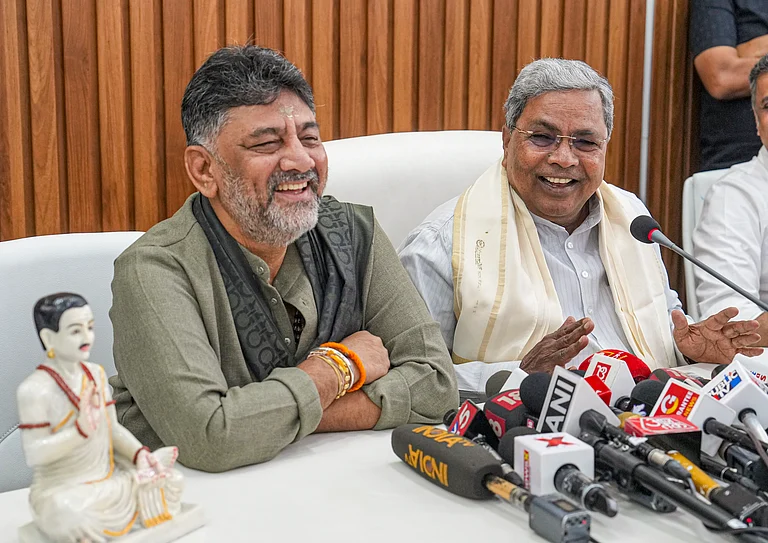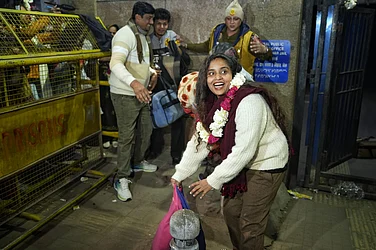After the abrogation of Article 370 on August 5, 2019, the Bharatiya Janata Party (BJP) is rewriting history in Jammu and Kashmir. It is downplaying the role of Sheikh Mohammad Abdullah in Kashmir’s history and replacing it with the last Dogra Maharaja Hari Singh.
The government has cancelled public holidays on December 5, the birth anniversary of Sheikh Mohammad Abdullah, the National Conference founder, former Prime Minister and then the Chief Minister of J&K. Till 2019, J&K would officially observe July 13 in remembrance of Kashmiris who fell to the bullet of the Dogra forces in 1931. It was also dropped from the list of holidays. The government at the same time decided to observe Maharaja Hari Singh’s birthday as a public holiday.
“The government has taken a decision to declare Maharaja Hari Singh Ji’s birthday as a public holiday. Maharaja Hari Singh was a great educationist, progressive thinker, social reformer and a towering man of ideas and ideals. The public holiday will be a fitting tribute to Maharaja Hari Singh Ji’s rich legacy,” said J&K Lieutenant Governor Manoj Sinha last year.
However, Sandeep Bamzai’s book Gilded Cage: Years That Made and Unmade Kashmir by Rupa Publications paints a different picture of Sheikh Mohammad Abdullah and Maharaja Hari Singh. Prior to 1947, Hari Singh dreamt of independent Kashmir and wanted to see himself as ruler of Eastern Switzerland while his Prime Minister Ram Chandra Kak and Swami Sant Deo pushed the last ruler of J&K to realise his dream of independent Kashmir. Only impediment to stall the dream was Sheikh Mohammad Abdullah and he did it.
“If Kashmir acceded to India, it was primarily due to the patriotic mindset of Sheikh Mohammad Abdullah, who adopted an antagonistic approach against Jinnah’s sectarian and communal thinking. Both were tall Muslim leaders, both were alumnus of the Aligarh Muslim University but diametrically divergent in their worldviews,” Bamzai writes in the book, praising Sheikh for the role he played in the turbulent year of 1947.
Who was Swami Sant Deo? Karan Singh explains in an interesting foreword of the book. He writes, “Bapu ji was a patriot and a nationalist. One of the most powerful figures of the time was Swami Sant Deo, a RSS shadowy figure who constantly misled my father. He would whisper in Bapuji’s ear: ‘aapka jhanda Lahore pe chadega, Kashmir phir se raj karega (Your flag will be raised in Lahore, Kashmir will rule again).’ He was one of the many who planted the seed of remaining independent in my father’s head.”
Singh further states, “As a ruler, he (Hari Singh) had been progressive, although I must add here that Kashmiri Pandit historians have been grossly unfair to him.”
And Bamzai doesn’t beat around the bush. He calls Hari Singh as a king whose priority was preservation of his rule. But he praises him for bringing the state subject ordinance, which was later renamed as Permanent Resident. He calls it revolutionary legislation. He holds Maharaja Hari Singh’s “several blunders” responsible that led to Kashmir undecided about its future on August 15 1947. He ignores Maharaja Hari Singh and gives credit to Sheikh for the accession.
“The accession was legally made by the Maharaja Hari Singh on the advice of Sheikh Abdullah, leader of the Jammu and Kashmir National Conference, the political party commanding the widest popular support in the state,” Bamzai writes.

Bamzai brings four characters to the fore in his 136-page short but interesting book and then makes us see politics beyond Sheikh Abdullah and Hari Singh in the first two chapters.
Hari Singh’s wife Maharani Tara Devi and her appointed Deputy Prime Minister Ram Lal Batra were for accession with India. Ram Chandra Kak was for independence, even for accession with Pakistan, and Swami Sant Deo wanted to see Hari Singh as ruler of an independent Kashmir. On June 18, 1947, when Lord Mountbatten paid a visit to Kashmir to persuade the Maharaja to not make any declaration of independence but opt for either India or Pakistan by August 14, 1947, the Maharaja conveyed to Mountbatten that he wished to be independent.
As Mountbatten conveyed to Pandit Jawaharlal Nehru what was going on in the Maharaja’s mind, Nehru on August 1, 1947, sent Gandhi to Kashmir to meet Hari Singh. Gandhi sought release of Sheikh Abdullah from the jail and dismissal of Ram Chandra Kak. Consequently, Kak was asked to resign on August 11, 1947 and General Janak Singh was appointed new PM. Jinnah could have stalled the move. But he didn’t. A day later, Maharaja signs a stand-still agreement with Pakistan and India. Bamzai states Kak was given assurance by Jinnah that Kashmir's sovereignty would be respected and Pakistan would help it in every possible manner if India refuses to sign a stand-still agreement.
Congress’s all cards were on the National Conference and Sheikh Abdullah. And they played well for Congress. Sheikh strategically remained away from accession debate and focussed on what Bamzai says “fundamental issue, namely, ending autocracy”. In the meanwhile, rebellion broke out in Poonch. Bamazi states the rebels were supplied ammunition, trucks and fuel with knowledge of British commander-in-chief General Masservy while Sheikh remained aloof to Pakistani overtures.
Bamzai delves deep into the subsequent first war between India and Pakistan over Kashmir and the role of Britain in it. He produced documents to buttress his claim. He states that it was on the recommendation of Pakistan Army commander-in-chief General Douglas Gracey that regular units were sent to Kashmir in 1948. While Bamzai tries to hold the British responsible for Kashmir crises of 1947 and he also doesn’t spare Americans, blaming them for the subsequent internationalisation of Kashmir issue as “the US had realised that Kashmir should be part of its sphere of influence”.
Bamzai quotes from notes of the Deputy Prime Minister Bakshi Ghulam Mohammad to Nehru about UN observers in Kashmir “abusing their position” and “engaging in what appears to be spying within the state” and US ambassador Loy Henderson’s meeting with Sheikh Mohammad Abdullah.
Abdullah had advocated Kashmir’s independence as an option with Henderson in his meeting on September 29, 1950. Bamzai, however, moves away from the popular narrative that Sheikh Abdullah narrated to American Democratic leader Adlai Stevenson about Kashmir independence, saying Nehru himself had said Sheikh was not to blame for it.
Bamzai holds Abdullah solely accountable for August 9, 1953, when he was arrested.
“While Abdullah had delivered Kashmir due to his antipathy for Jinnah and his two-nation theory, his personality being what it was, it was proving to be difficult to deal with extreme mood swings,” writes Bamzai.
Bamzai further says in the battle between the road to integration and greater autonomy for Jammu and Kashmir, Bakshi was openly batting for India and Mirza Afzal Beg for Abdullah.
“In an internal National Conference coup, Abdullah was toppled by Bakshi, who took over the reins of the state as its PM,” says Bamzai. Was it so simple? As if Nehru was a mere innocent bystander in the event.
Bamzai talks much about the Constituent Assembly of J&K and its ratification of Kashmir’s accession on February 15, 1954. He calls it a move that defied the then omnipotent United Nations Security Council (UNSC). But in the epilogue of the book, he seems to be in awe of Modi government for reading down Article 370 and feels “tortuous and often treacherous pathways of the past, which always led to a cloud of flies buzzing over India’s constitutional, legal and moral right over the valley, have been consigned, hopefully, to the rubbish heap of the history”.
With the BJP doing away with the state subject and other laws, Bamzai forgets he had mentioned it a “revolutionary legislation” in his book. He ignores the devastating impact of reading down Article 370 on Abdullahs with both Farooq Abdullah and Omar Abdullah arrested under Public Safety Act. Perhaps, he feels it is not worth a sentence.
The author devotes many pages to migration of Kashmiri Pandits from the Valley. He ignores killings of National Conference workers while saying between December 1989 to May 15, 1990, 134 innocent persons were killed by the “rampaging militants” without disclosing the identity of the killed.
Bamzai’s book is yet another addition to Kashmir’s political literature of 1947. It is a quick and fascinating read with new documents and letters, especially from Dwarkanath Kachru revealing to Nehru insights of Sheikh Abdullah’s mind in the1950s. More pages on the role of Prime Minister Ram Chandra Kak and his advisor Swami Sant Deo would have made the book richer.


























